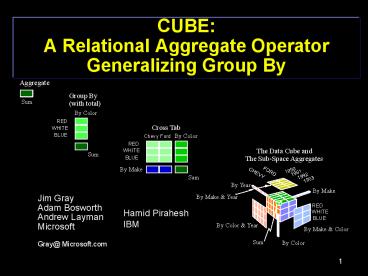CUBE: A Relational Aggregate Operator Generalizing Group By PowerPoint PPT Presentation
Title: CUBE: A Relational Aggregate Operator Generalizing Group By
1
CUBE A Relational Aggregate Operator
Generalizing Group By
Jim Gray Adam Bosworth Andrew Layman Microsoft Gr
ay_at_ Microsoft.com
Hamid Pirahesh IBM
2
The Data Analysis Cycle
- User extracts data from database with query
- Then visualizes, analyzes data with desktop tools
3
Division of laborComputation vs Visualization
- Relational system builds CUBE relation
- aggregation best done close to data
- Much filtering of data possible
- Cube computation may be recursive
- (e.g., percent of total, quartile, ....)
- Visualization System displays/explores the cube
4
Relational Aggregate Operators
- SQL has several aggregate operators
- sum(), min(), max(), count(), avg()
- Other systems extend this with many others
- stat functions, financial functions, ...
- The basic idea is
- Combine all values in a column
- into a single scalar value.
- Syntax
select sum(units) from inventory
5
Relational Group By Operator
- Group By allows aggregates over table sub-groups
- Result is a new table
- Syntax
select location, sum(units) from
inventory group by location having nation
USA
6
Problems With This Design
- Users Want Histograms
- Users want sub-totals and totals
- drill-down roll-up reports
- Users want CrossTabs
- Conventional wisdom
- These are not relational operators
- They are in many report writers and query engines
F() G() H()
7
Thesis The Data CUBE Relational Operator
Generalizes Group By and Aggregates
8
The Idea Think of the N-dimensional CubeEach
Attribute is a Dimension
- N-dimensional Aggregate (sum(), max(),...)
- fits relational model exactly
- a1, a2, ...., aN, f()
- Super-aggregate over N-1 Dimensional sub-cubes
- ALL, a2, ...., aN , f()
- a3 , ALL, a3, ...., aN , f()
- ...
- a1, a2, ...., ALL, f()
- this is the N-1 Dimensional cross-tab.
- Super-aggregate over N-2 Dimensional sub-cubes
- ALL, ALL, a3, ...., aN , f()
- ...
- a1, a2 ,...., ALL, ALL, f()
9
An Example
CUBE
10
Why the ALL Value?
- Need a new Null value (overloads the null
indicator) - Value must not already be in the aggregated
domain - Cant use NULL since may aggregate on it.
- Think of ALL as a token representing the set
- red, white, blue, 1990, 1991, 1992, Chevy,
Ford - Rules for ALL in other areas not explored
- assertions
- insertion / deletion / ...
- referential integrity
- Follow set of values semantics.
11
CUBE operator Syntax
- Proposed syntax
- Note Group By operator repeats aggregate list
- in select list
- in group by list
select model, make, year, sum(units) from
car_sales where model in chevy, ford and
year between 1990 and 1994 group by model,
make, year with cube having sum(units) gt 0
12
Why This Syntax?
- abstract syntax
- allows functional aggregations (e.g., sales by
quarter)
select ltfield listgt ltaggregate listgt from
lttable expressiongt where ltsearch
conditiongt group by ltaggregate listgt with
cube roll up having ltsearch conditiongt
select store, quarter, sum(units) from
sales where nation Mexico group by store,
quarter(date) as quarter with roll up and year
1994
13
Decorations and Abstractions
- Sometimes want to tag cube with redundant values
- region , region_name, sales
- region name is not a dimension, it is a
decoration - Decorations are functionally dependent on
dimensions - More interesting, some dimensions are
aggregations. - Often these aggregations are not linear (are a
lattice) - Rather than treat time as 12 dimensions
- Recognize abstractions as one dimension (like
decorations) - Compute efficiently (virtual functions)
14
Interesting Aggregate Functions
- From RedBrick systems
- Rank (in sorted order)
- N-Tile (histograms)
- Running average (cumulative functions)
- Windowed running average
- Percent of total
- Users want to define their own aggregate
functions - statistics
- domain specific
15
User Defined Aggregates
- Idea
- User function is called at start of each group
- Each function instance has scratchpad
- Function is called at end of group
- Example SUM
- START allocates a cell and sets it to zero
- NEXT adds next value to cell
- END deallocates cell and returns value
- Simple example MAX()
- This idea is in Illustra, IBMs DB2/CS, and
SQL standard - Needs extension for rollup and cube
start
next
Scratchpad
end
16
User Defined Aggregate Function Generalized For
Cubes
- Aggregates have graduated difficulty
- Distributive can compute cube from next lower
dimension values (count, min, max,...) - Algebraic can compute cube from next lower lower
scratchpads (average, ...) - Holistic Need base data (Median, Mode, Rank..)
- Distributive and Algebraic have simple and
efficient algorithm build higher dimensions
from core - Holistic computation seems to require multiple
passes. - real systems use sampling to estimate them
- (e.g., sample to find median, quartile boundaries)
17
How To Compute the Cube?
- If each attribute has Ni values CUBE has P
(Ni1) values - Compute N-D cube with hash if fits in RAM
- Compute N-D cube with sort if overflows RAM
- Same comments apply to subcubes
- compute N-D-1 subcube from N-D cube.
- Aggregate on biggest domain first when gt1 deep
- Aggregate functions need hidden variables
- e.g. average needs sum and count.
- Use standard techniques from query processing
- arrays, hashing, hybrid hashing
- fall back on sorting.
18
Example
- Compute 2D core of 2 x 3 cube
- Then compute 1D edges
- Then compute 0D point
- Works for algebraic and distributive
functionsSaves lots of calls
19
Summary
- CUBE operator generalizes relational aggregates
- Needs ALL value to denote sub-cubes
- ALL values represent aggregation sets
- Needs generalization of user-defined aggregates
- Decorations and abstractions are interesting
- Computation has interesting optimizations
- Research Topics
- Generalize Spreadsheet Pivot operator to RDBs
- Characterize Algebraic/Distributive/Holistic
functions for update

